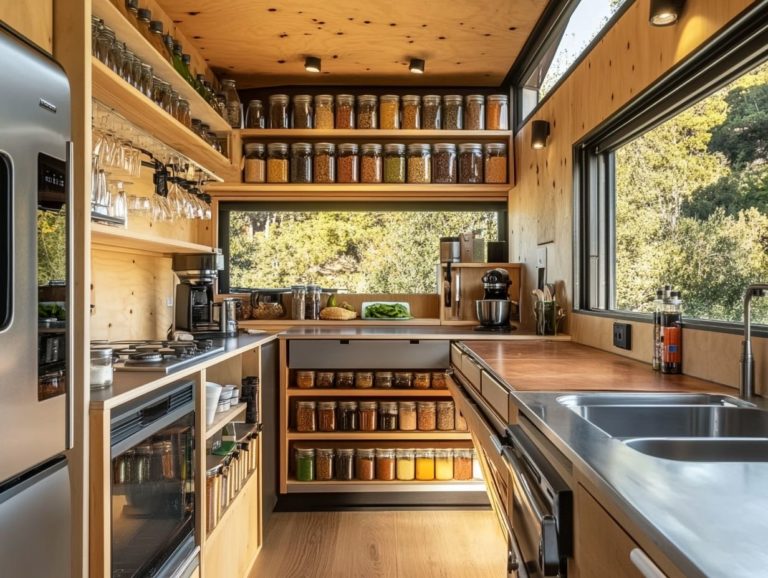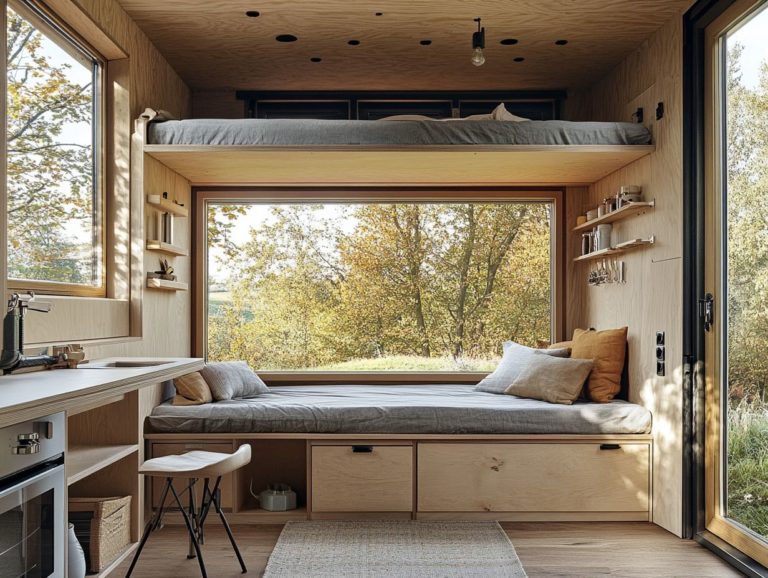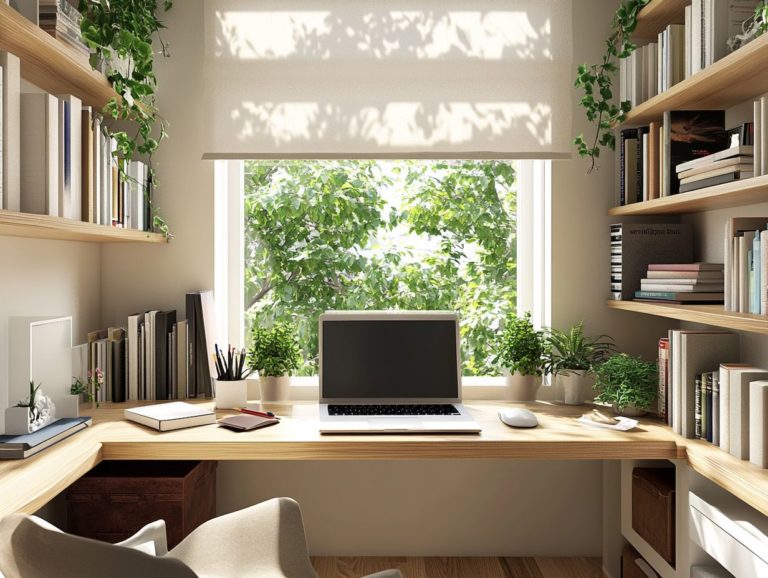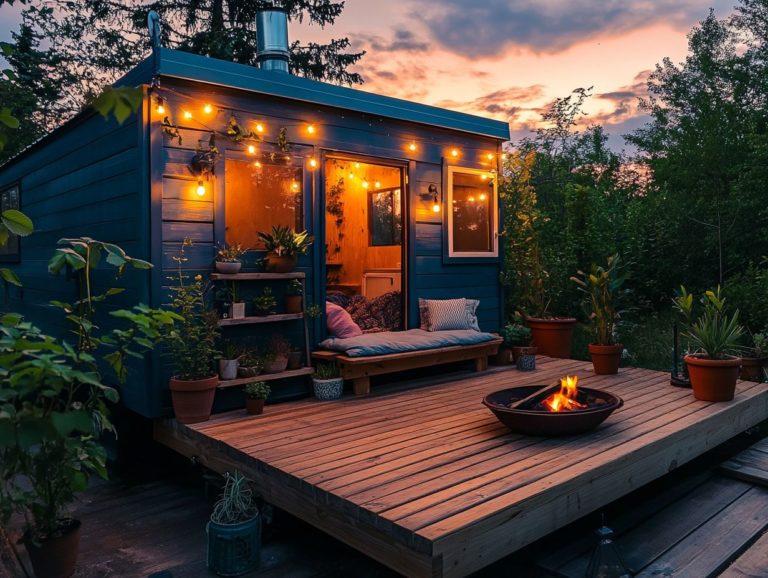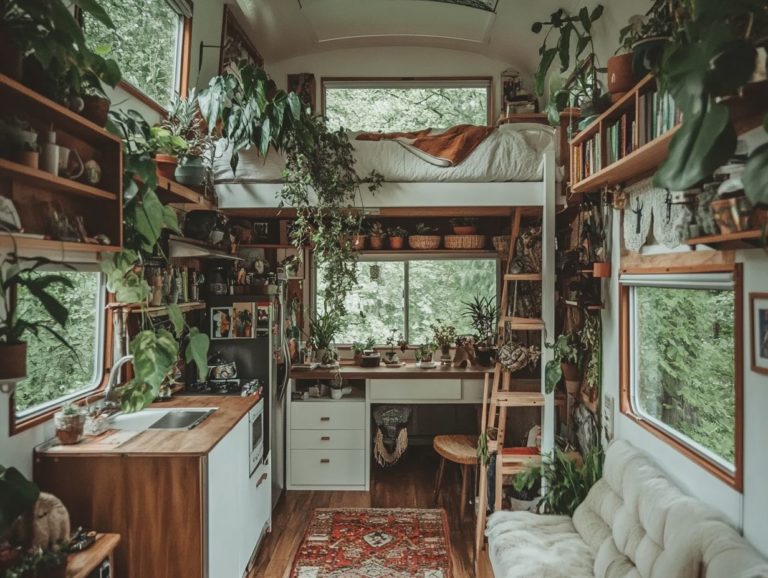7 Ways to Enhance Functionality in Tiny Spaces
Living in a tiny space offers challenges but also sparks creativity. As urban living grows, making the most of your space has become essential.
Whether you’re in a small apartment or want to make a cozy nook feel bigger, there are great ways to transform your environment. This article explores seven innovative ideas to enhance small space solutions from using vertical space to choosing furniture that serves more than one purpose.
Discover how to elevate your small space, making it not just livable but a delightful retreat.
Contents [hide]
- Key Takeaways:
- 1. Utilize Vertical Space
- 2. Choose Multi-Functional Furniture
- 3. Use Mirrors to Create the Illusion of Space
- 4. Invest in Storage Solutions
- 5. Incorporate Light Colors and Natural Light
- 6. Minimize Clutter
- 7. Create a Sense of Continuity
- How Can Tiny Spaces Be Made More Functional?
- Frequently Asked Questions
- What Are Some Ways to Enhance Functionality in Tiny Spaces?
- How Can Vertical Space Be Utilized in Tiny Spaces?
- Why Is Investing in Multi-Purpose Furniture Important in Tiny Spaces?
- What Are Some Ways to Create the Illusion of a Larger Space in a Tiny Room?
- How Can Storage Be Maximized in Tiny Spaces?
- Why Is It Important to Regularly Assess and Declutter a Tiny Space?
Key Takeaways:
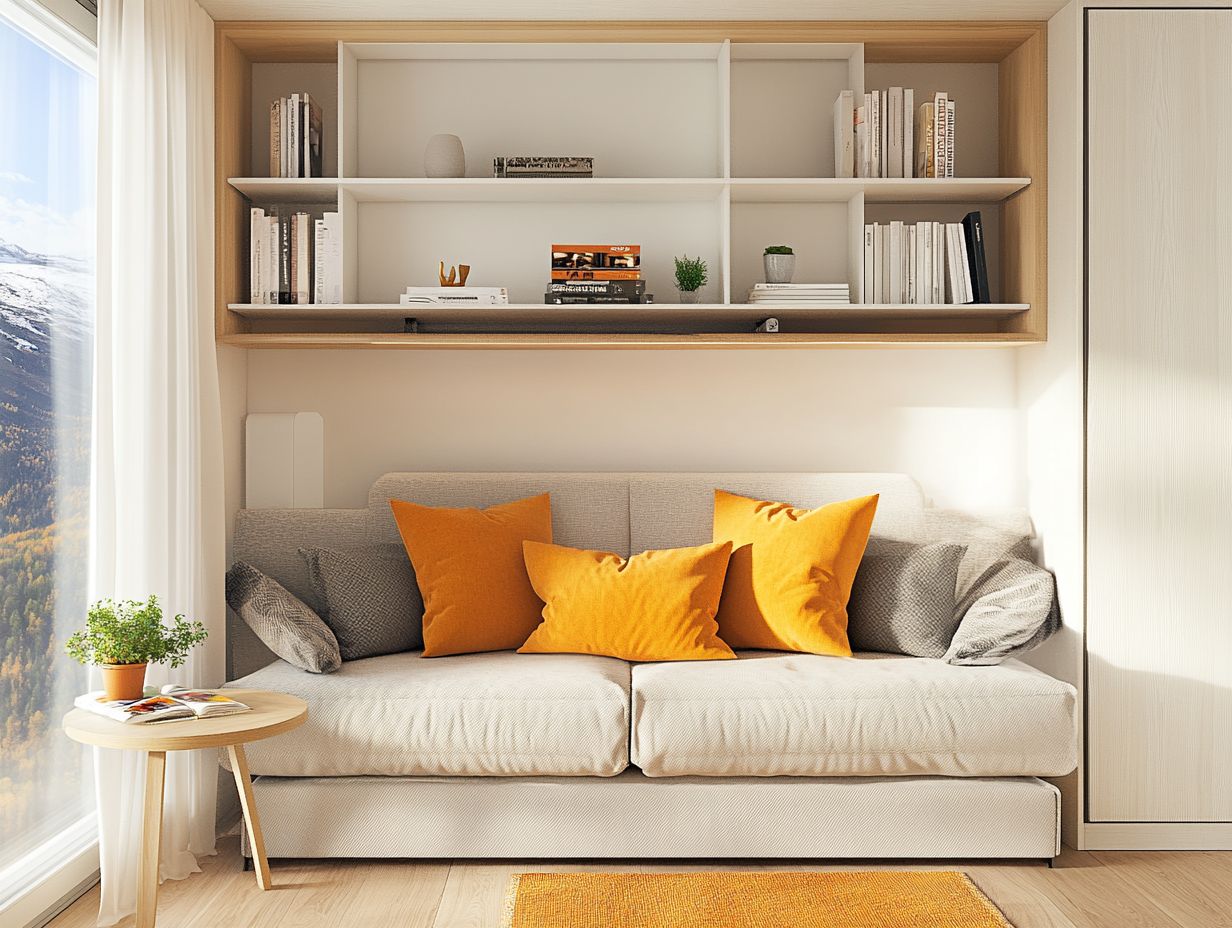
- Utilize vertical space for storage and visual interest.
- Choose multi-functional furniture to save space and add versatility.
- Incorporate mirrors to create the illusion of a larger space and reflect light.
1. Utilize Vertical Space
Using vertical space can transform compact rooms where every inch counts. This approach maximizes height while keeping your space stylish and comfortable.
By adding shelves and wall-mounted units, you can declutter and showcase your favorite d cor items. For instance, floating shelves draw the eye upward and provide a perfect spot for plants or artwork without taking up valuable floor space.
Hanging d cor like ceiling-mounted baskets or suspended plants extends your storage options, making clever use of the vertical expanse. Smart designs, such as furniture that serves more than one purpose that combines seating with storage, help keep your home organized.
2. Choose Multi-Functional Furniture
Choosing multi-functional furniture is key to optimizing small spaces. These pieces save room and enhance functionality.
Consider fold-down tables, convertible sofas, and hidden storage units to make every square inch count. For example, a stylish fold-down table can easily shift from a work surface during the day to a dining area at night, adapting to your needs.
A convertible sofa offers comfortable seating by day and transitions into a cozy bed for guests at night, perfect for those who love to entertain.
3. Use Mirrors to Create the Illusion of Space
Using mirrors strategically helps create the illusion of space in compact rooms. Mirrors enhance light and make your home feel more inviting.
Place mirrors across from windows or light sources to bounce natural light around. This brightens dark corners and creates an impression of spaciousness.
Oversized mirrors not only serve as striking focal points but also amplify the perception of depth, making them perfect for small-scale designs. These larger pieces can reflect outdoor views, adding a sense of openness.
4. Invest in Storage Solutions
Investing in effective smart storage solutions is essential for maintaining organization in small spaces. These solutions allow you to make the most of every nook and cranny while keeping your living environment beautifully clutter-free.
Incorporate smart storage options like vertical shelving and hidden compartments to maximize your square footage without sacrificing style. Vertical storage takes advantage of wall space, drawing the eye upward and creating the illusion of a larger room. Cleverly designed hidden compartments can discreetly conceal items that might otherwise contribute to a chaotic atmosphere.
These thoughtful solutions encourage tidiness and cultivate an inviting ambiance, making your small home feel more spacious and welcome for both you and your guests.
5. Incorporate Light Colors and Natural Light
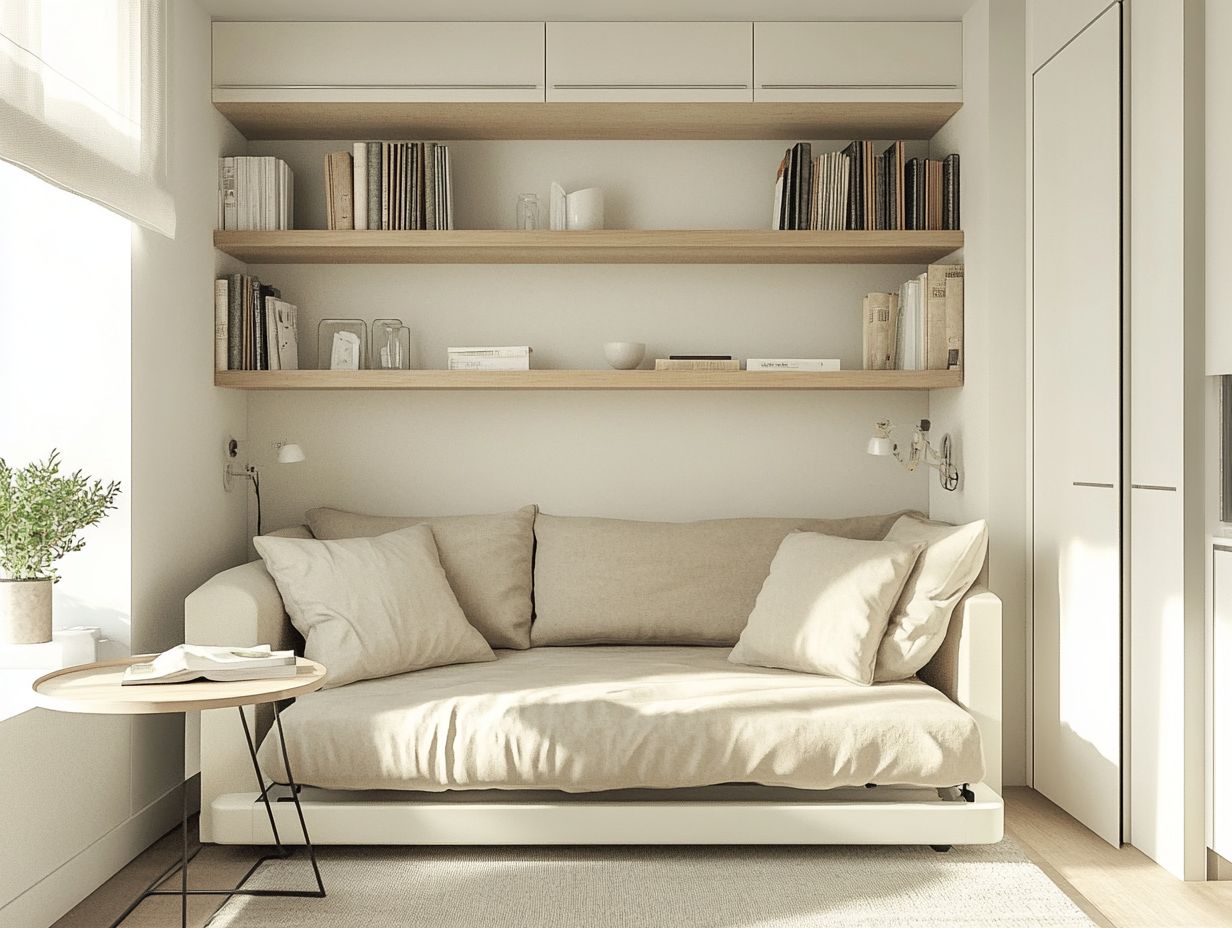
Incorporating light colors and maximizing natural light can transform your small space. This creates an open concept feel that enhances airiness and comfort in compact rooms.
This approach reshapes how you perceive space and influences your mood and overall well-being. Opt for soft hues in your walls and furnishings to make the environment feel more expansive and inviting.
Optimize your window treatments with sheer curtains or light-filtering shades. This allows an abundance of natural light to pour in while maintaining the privacy you need.
The perfect blend of light colors and ample sunlight fosters a harmonious atmosphere. This creates a serene sanctuary, even in the coziest of settings.
6. Minimize Clutter
Minimizing clutter is essential in small spaces. It enhances functionality and creates a serene and inviting atmosphere that fosters relaxation and creativity, especially when using minimalism as a guiding principle.
To achieve this, adopt strategies like the ‘one in, one out’ rule. Every time you bring something new into your home, commit to removing an existing item. This encourages thoughtful purchasing habits and prevents unnecessary accumulation.
Innovative storage solutions like multi-functional furniture or vertical shelving can transform even the tiniest rooms into organized sanctuaries.
Incorporating minimalist design choices, such as neutral color palettes and streamlined decor, supports your decluttering efforts. These choices cultivate a sense of calm, making it easier to maintain a clutter-free environment.
7. Create a Sense of Continuity
Creating a sense of continuity in small spaces is essential for achieving a harmonious flow. This allows for seamless transitions and clearly defined zones, enhancing both the functionality and aesthetics of compact rooms.
Utilize consistent materials and a cohesive color palette to tie together different areas. This fosters an environment where each section feels connected rather than disjointed. In open concept design, this approach encourages fluid movement from one space to another.
Effective design in smaller interiors is not merely a luxury it’s a necessity. It dramatically shifts your perception of space, making areas appear larger and more inviting. By incorporating uniformity in both textures and tones, you create an inviting atmosphere that transforms limited square footage into a beautifully integrated living experience.
How Can Tiny Spaces Be Made More Functional?
Transforming tiny spaces into functional havens requires innovative small space solutions that emphasize multi-functional furniture and clever storage techniques. This approach ultimately crafts inviting and practical environments.
To achieve this, consider selecting pieces that serve multiple purposes. For example, a sofa that effortlessly converts into a bed or an ottoman that hides away your clutter with style. Embracing layout designs that maximize floor space, along with decorating tips for small tiny house spaces, creates a more airy and spacious ambiance.
Don t overlook vertical storage solutions, like wall-mounted shelves and pegboards. These options not only optimize space but also add a touch of flair.
Combine these elements to transform your compact areas into cozy yet efficient living spaces that reflect both style and functionality!
Tackling the Challenges of Small Space Design!
Designing for small spaces brings its own set of challenges. These include limited storage, the need for functional zones, and how to create an inviting atmosphere without overwhelming the area, especially when considering small-scale design.
To overcome these hurdles, designers often use multifunctional furniture that maximizes utility while minimizing both physical and visual clutter. For instance, modular seating can effortlessly transform into beds, and expandable tables accommodate guests without sacrificing precious space.
The choice of color palette and lighting is crucial in achieving a sense of balance and airiness. Lighter hues can make your space feel larger and more open. Meanwhile, strategic lighting adds depth and warmth.
By thoughtfully considering these elements, you can create an environment that is not only practical but also visually appealing. Ensure that every corner serves a purpose!
What Are Some Creative Storage Solutions for Tiny Spaces?
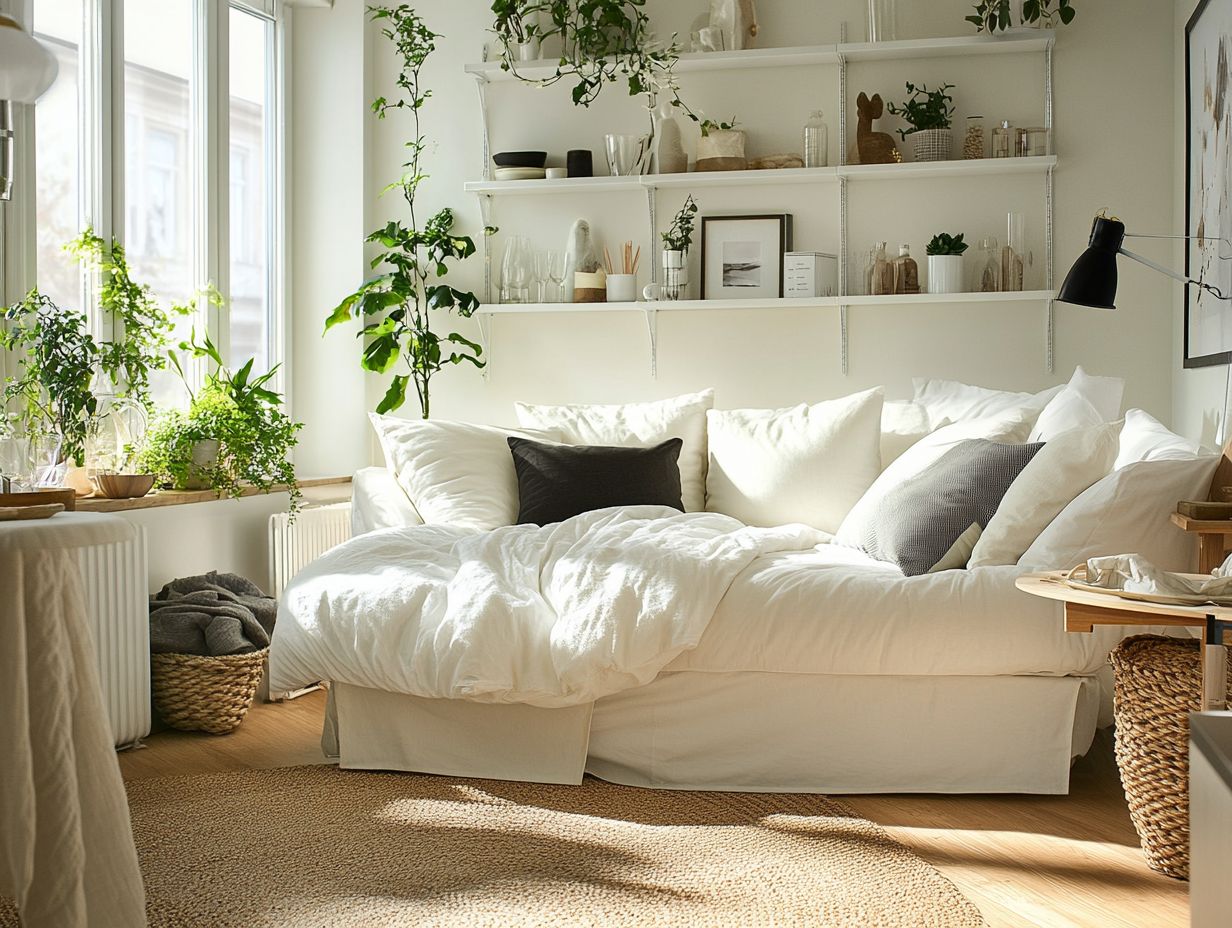
Creative storage solutions are crucial in tiny spaces. They allow you to utilize hidden storage and vertical options to maximize every square inch while keeping your home clutter-free and functional.
One of the most innovative approaches is under-bed storage. This lets you reclaim wasted space. By using containers or drawers that slide effortlessly under your bed, you can easily stow away seasonal clothing or extra linens without losing accessibility.
Wall-mounted racks not only act as stylish decor but also offer practical storage for kitchen utensils, books, or even plants. These solutions blend seamlessly into small home designs, providing both aesthetic appeal and functionality. This ensures that every nook and cranny has a purpose within your space!
How Can One Optimize Natural Light in a Small Space?
Optimizing natural light in a small space is essential for cultivating a bright and airy atmosphere. Make strategic choices like installing large windows, opting for light colors, and incorporating biophilic design elements. This can significantly enhance the feel of the area.
These foundational elements are crucial, so consider incorporating sheer window treatments. These not only maximize daylight but also provide the privacy you desire, enhancing the overall sense of openness.
Selecting light-colored fabrics for curtains, blinds, or shades allows more sunlight to flood the space while reflecting it, amplifying its effect.
Positioning mirrors thoughtfully across from windows can create an illusion of greater depth and brightness. This effectively doubles the light that graces the room.
By integrating these practical solutions along with light colors in your decor, you can elevate the luminosity and warmth of your space, transforming it into a harmonious retreat!
Start transforming your small space today with these creative solutions!
What Are Some Space-Saving Furniture Ideas?
Space-saving furniture ideas are essential for maximizing functionality in small spaces. Consider options like fold-down furniture and multi-functional designs that effortlessly blend into your environment.
A wall-mounted desk can transform an otherwise unused corner into a productive workspace. It retracts neatly when not in use.
Similarly, ottomans that double as storage units can help you maintain a clutter-free living area. They also provide extra seating for guests.
These versatile pieces save valuable square footage and enhance your home’s overall aesthetic. They harmonize style with practicality.
By incorporating such functional furnishings, you can create a more organized and visually appealing atmosphere. This allows you to make the most of every inch without compromising on comfort or design.
How Can One Incorporate Personal Style in a Small Space?
You can definitely infuse your personal style into your small space with some smart choices in colors and textures. This ensures your environment feels inviting while reflecting your unique taste.
Carefully selecting artwork that resonates with you infuses vibrancy and character into your surroundings. Accessories, whether they re bold statements or subtle accents, provide focal points that spark conversation.
Utilizing a curated color palette allows for a cohesive design, enabling various elements to complement one another beautifully. The key lies in balancing these choices to create a personalized sanctuary that embodies your unique flair while keeping things simple and uncluttered.
Check out this video for more space-saving tips!
Frequently Asked Questions
What Are Some Ways to Enhance Functionality in Tiny Spaces?
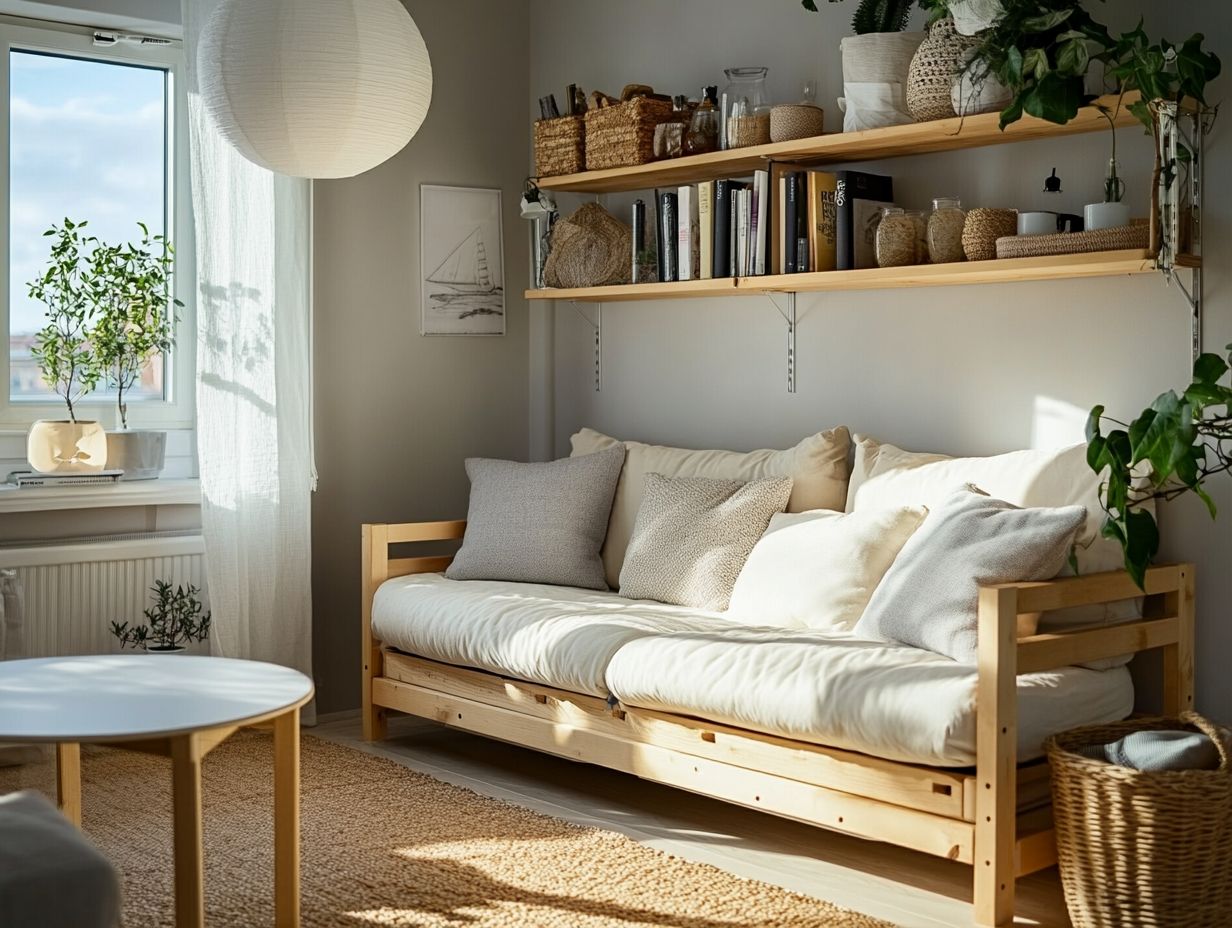
1. Utilize vertical space by adding shelves or hanging storage options.
2. Invest in multi-purpose furniture, such as a sofa bed or a coffee table with storage.
3. Use light colors and mirrors to create the illusion of a larger space.
4. Maximize natural light by keeping windows unobstructed and using sheer curtains.
5. Get creative with storage by using under bed storage, storage ottomans, and hanging organizers.
6. Use furniture with built-in storage, such as a desk with drawers or a bed with built-in shelves.
7. Declutter regularly to ensure everything serves a purpose and has a designated spot.
How Can Vertical Space Be Utilized in Tiny Spaces?
In tiny spaces, it’s important to make use of every inch. This includes utilizing vertical space by adding shelves, hanging storage options, and using wall space for storage or decoration.
Why Is Investing in Multi-Purpose Furniture Important in Tiny Spaces?
In small spaces, it’s crucial to have furniture that serves more than one purpose. This allows for more functionality in a smaller area and can save space and money in the long run.
What Are Some Ways to Create the Illusion of a Larger Space in a Tiny Room?
Using light colors, mirrors, and maximizing natural light are great ways to create the illusion of a larger space. These elements can help open up the room and make it feel more spacious.
How Can Storage Be Maximized in Tiny Spaces?
In tiny spaces, storage can be maximized by getting creative with options like under bed storage, storage ottomans, and hanging organizers. Regularly decluttering also helps ensure everything has a designated spot.
Why Is It Important to Regularly Assess and Declutter a Tiny Space?
In a small space, it’s important to regularly assess and declutter to ensure everything serves a purpose and has a designated spot. This prevents the space from feeling cluttered and overwhelming and makes room for new items if needed.


